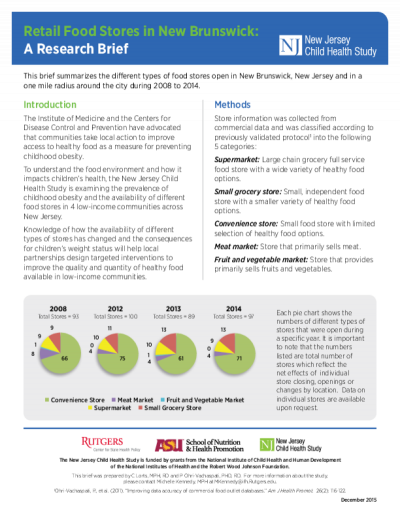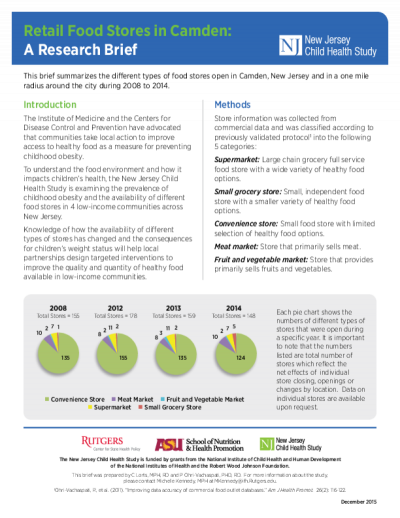The New Jersey Childhood Obesity Study, funded by the Robert Wood Johnson Foundation, aims to provide vital information for planning, implementing and evaluating interventions aimed at preventing childhood obesity in five ew Jersey municipalities: Camden, Newark, New Brunswick, Trenton, and Vineland. These five communities are being supported by RWJF's New Jersey Partnership for Healthy Kids program to plan and implement policy and environmental change strategies to prevent childhood obesity.
Effective interventions for addressing childhood obesity require community specific information on who is most at risk and on contributing factors that can be addressed through tailored interventions that meet the needs of the community.
Using a comprehensive research study, the Center for State Health Policy at Rutgers University is working collaboratively with the State Program Office for New Jersey Partnership for Healthy Kids and the five communities to address these information needs. The main components of the study include:
• A household survey of 1700 families with 3 -18 year old children
• De-identified heights and weights data from public school districts
• Assessment of the food and physical activity environments using objective data
Data books and maps based on the results of the study are being shared with the community coalitions in the five communities to help them plan their interventions.
The New Jersey Childhood Obesity Study, funded by the Robert Wood Johnson Foundation, aims to provide vital information for planning, implementing and evaluating interventions aimed at preventing childhood obesity in five New Jersey municipalities: Camden, Newark, New Brunswick, Trenton, and Vineland.
These five communities are being supported by RWJF's New Jersey Partnership for Healthy Kids program to plan and implement policy and environmental change strategies to prevent childhood obesity.
Effective interventions for addressing childhood obesity require community-specific information on who is most at risk and on contributing factors that can be addressed through tailored interventions that meet the needs of the community.
Using a comprehensive research study, the Center for State Health Policy at Rutgers University is working collaboratively with the State Program Office for New Jersey Partnership for Healthy I<ids and the five communities to address these information needs. The main components of the study include:
• A household survey of 1700 families with 3 -18 year old children
• De-identified heights and weights data from public school districts
• Assessment of the food and physical activity environments using objective data
Data books and maps based on the results of the study are being shared with the community coalitions in the five communities to help them plan their interventions.

Frequent consumption of fruits and vegetables has been linked to better dietary quality and positive health outcomes. Unfortunately, fruit and vegetable consumption among elementary school children falls far short of the recommendations. Therefore, finding strategies to promote fruit and vegetable consumption in children is a public health priority. One such strategy is the United States Department of Agriculture’s (USDA) Fresh Fruit and Vegetable Program (FFVP), which provides fresh fruits and vegetables as snacks, at least twice per week, in elementary schools with high student enrollment from low-income households. The program aims to expand the variety of fruits and vegetables children experience, impacting their present and future health outcomes. Another USDA initiative, the Supplemental Nutrition Assistance Program Education (SNAP-Ed), offered in community and school settings, aims to improve the likelihood that SNAP eligible individuals will make healthy food choices consistent with the Dietary Guidelines for Americans. SNAP-Ed is a potential resource for FFVP schools, providing nutrition education, staff training, and promotional materials.

Many factors influence children’s health behaviors and health outcomes. The Social Ecological Model (SEM) groups these factors into interactive layers, creating a framework for understanding their influence and for designing interventions to achieve positive change. The layers of influence in the SEM include individual, interpersonal, organizational, community, and policy factors.

The New Jersey Childhood Obesity Study, funded by the Robert Wood Johnson Foundation, aims to provide vital information for planning, implementing and evaluating interventions aimed at preventing childhood obesity in five New Jersey municipalities: Camden, Newark, New Brunswick, Trenton, and Vineland. These five communities are being supported by RWJF's New Jersey Partnership for Healthy Kids program to plan and implement policy and environmental change strategies to prevent childhood obesity.
Effective interventions for addressing childhood obesity require community specific information on who is most at risk and on contributing factors that can be addressed through tailored interventions that meet the needs of the community.
Using a comprehensive research study, the Center for State Health Policy at Rutgers University is working collaboratively with the State Program Office for New Jersey Partnership for Healthy Kids and the five communities to address these information needs. The main components of the study include:
• A household survey of 1700 families with 3 -18 year old children
• De-identified heights and weights data from public school districts
• Assessment of the food and physical activity environments using objective data
Data books and maps based on the results of the study are being shared with the community coalitions in the five communities to help them plan their interventions.

This brief summarizes the different types of food stores open in New Brunswick, New Jersey and in a one mile radius around the city during 2008 to 2014.

Many factors influence children’s health behaviors and health outcomes. The Social Ecological Model (SEM) groups these factors into interactive layers, creating a framework for understanding their influence and for designing interventions to achieve positive change. The layers of influence in the SEM include individual, interpersonal, organizational, community, and policy factors (see figure). The New Jersey Child Health Study (NJCHS) was designed to examine how specific layers of the SEM, particularly food and physical activity environments in schools and communities, affect obesity outcomes in children

This brief summarizes the different types of food stores open in Camden, New Jersey and in a one mile radius around the city during 2008 to 2014.